KarRC RAS Director General and project leader Olga Bakhmet presented the results of the studies of carbon pools in mire ecosystems and agricultural landscapes of the republic. Surveys were conducted both in natural mire ecosystems and in drained sites, since drainage has affected significant areas in Karelia: 700 to 800 thousand hectares, according to different estimates. Eighteen sampling plots were established in the Kindasovo forest and mire research station in southern Karelia. Scientists estimated carbon stock in peat, soils, above-ground and underground plant biomass.
— The main carbon sink in mire ecosystems is the peat deposit. As studies have shown, the top one meter of the peat deposit, including poorly decomposed organic matter, contains 115-215 tons of carbon per hectare. As for vegetation, the underground plant biomass accounts for 65-90% in open mire areas, while, for example, the above-ground biomass of single trees is no more than 1.5%. That is, the bulk of carbon accumulated in vegetation is stored underground. The situation in drained mire sites was quite different - tree biomass rose to 23%. If we look at the contribution of different plants to carbon stocks, the main accumulators of carbon in mires are Sphagnum mosses, - said Olga Bakhmet.
Last year, studies were also continued on farmlands in various succession stages: from active hayfields and areas with isolated clumps of shrubs and trees to areas with a continuous secondary vegetation cover.
— The studies included identification of plant species and the areas they have already occupied and, of course, the processes of carbon accumulation both in the vegetation and in soils of these areas were investigated. Data on carbon stocks in the root layer and in the top meter of soil were obtained. Studies show that as farmlands become overgrown, more carbon is accumulated in vegetation, which is quite natural as there appear woody plants, in which carbon stocks are significant. In soils, organic matter accumulation is slower and stocks change less significantly across succession stages. The highest carbon stocks are found where peatlands become overgrown with a solid vegetation cover. This process involves an increase in moisture content, which contributes to carbon accumulation, — remarked Olga Bakhmet.
The soil scientist also spoke about the development of a monitoring system for measuring carbon fluxes and greenhouse gas emissions in agricultural landscapes. Sampling plots for such measurements are located on farmland at different succession stages.
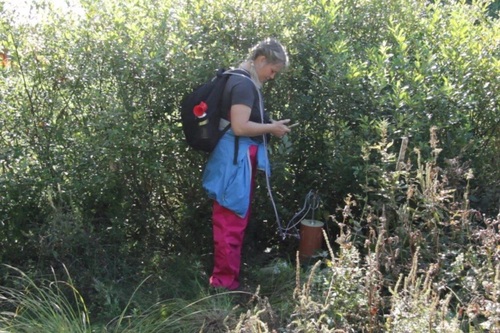
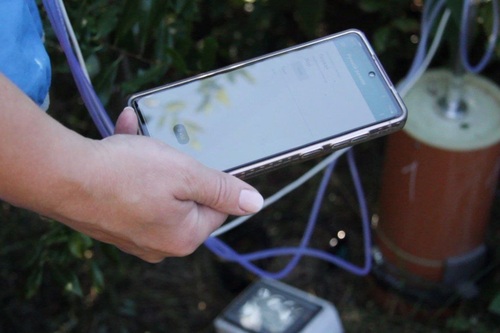
Carbon dioxide emission from soil being measured by Svetlana Vanag, Junior Researcher of the Laboratory for Ecological Monitoring and Modeling, Department for Multidisciplinary Research KarRC RAS.
— Last year the first measurements were made and very interesting data were obtained, but it is too early to draw some conclusions, since the emission volume is highly dependent on temperature and moisture, on specific features of the annual cycle. This work should be continued so that reliable conclusions can be drawn based on the results of more than one year of measurements, — said the scientist.
The scientists' plans for the current year include polishing the technique for determining carbon pools in drained land, as it is necessary to take into account the increased accumulation of organic matter in the drainage network. It is also planned to use satellite images to analyze the state of agricultural landscapes and identify their revegetation status.
Another activity area for the RITM Carbon consortium is studies of carbon in forest ecosystems. In Karelia, this task is handled by specialists of the Forest Research Institute (FRI) KarRC RAS. Studies of the carbon balance of northern forests are carried out in the intensive testing ground of type I, which is located in the Kivach Nature Reserve. A network of 30 permanent sampling plots representing the diversity of forest communities in the study area was established on a 2*2 square kilometer area. In each sampling plot a set of activities was carried out to estimate the main carbon pools; arrangements were made for estimating CO2 emissions and for other studies according to the methods adopted by the consortium. Carbon stock was determined in soil, forest floor, coarse woody debris, and living plant biomass.
— The carbon sequestering capacity of boreal forests proved to be underestimated: Russian forests sequester more carbon than thought before. We found that the old-growth pine forests in our testing group contain some 200 tons carbon per hectare, — shared Alexander Kryshen, Director of the Forest Research Institute KarRC RAS.
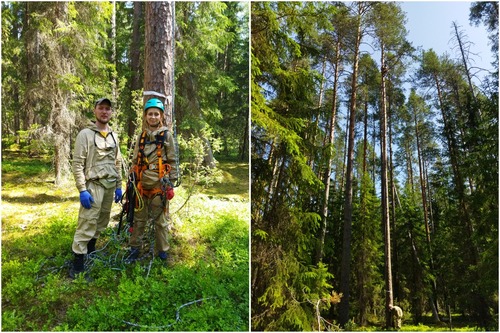
To get a shoot from the crown, Natalia Galibina, Principal Researcher at the Laboratory of Woody Plant Physiology and Cytology FRI KarRC RAS, climbs up to 25 m height. The photo on the right shows operations at height.
In 2024, in addition to the work at the testing ground, the scientists conducted research at three BGC (biogeocoenosis) sites, where a total of 16 sampling plots were established in forests of the Kondopoga District. The monitoring covered managed forest areas in different stages of the post-logging succession: in sites harvested 0-10 years, 40-50 years, and 80-100 years ago. The researchers elucidated changes in carbon stocks after logging and during forest regeneration.
The studies once again emphasized the importance of natural old-growth forests in climate regulation. The forest ecosystem continues to accumulate and retain carbon, even though the increment of woody biomass is reduced. The climate-regulating role of forests is also evidenced by data on the transport of carbohydrates via trunk tissues (phloem) from the tree crown to the roots and then to the soil. Just like the data on carbon content in plant biomass, soil and dead wood, this information is important for understanding the patterns of carbon accumulation and emission in forest ecosystems and will eventually be used to adjust the models for calculating the carbon budget in Russian forests.

Staff of FRI KarRC RAS doing forest valuation operations. Left to right: Dmitry Teslya, Ivan Romashkin, and Sergey Moshnikov
In particular, scientists at the Forest Research Institute found that even if only the difference in carbon content between different wood parts (sapwood and heartwood) is not taken into account, the carbon content can be underestimated by 10% or even more. Furthermore, the studies showed that the harsher the climatic and edaphic conditions, the higher the carbon content in stem wood and in the ground cover. These results are important for assessing the climate-regulating role of boreal forests.
The studies of greenhouse gas sequestration and emission in aquatic ecosystems were presented by Yulia Lukina, Director of the Northern Water Problems Institute (NWPI) KarRC RAS.
— Globally, the main sources of carbon dioxide are considered to be Arctic and boreal lakes located in paludal areas, since peatlands are the biggest stores of terrestrial carbon. In Karelia, such humified lakes with boggy catchments are the most common. They are small in area, but can contribute significantly to emissions, — explained Yulia Lukina.
Scientists conduct research on three model water bodies within the Kivach Nature Reserve: the small forest lake Chudesnaya Lamba, the Sandalka River and the Chechkin Brook.
In 2024, the forms of carbon in water in different seasons and the amount of carbon removal from the catchment area were determined.
Chechkin Brook is a typical small watercourse fed by mires. It was found that during the year 217 tons of carbon were removed from the catchment area via the brook, with maximum removal in the form of dissolved organic matter and humic substances in April and May. Dissolved carbon dioxide outflow also increases during the spring high water period. During summer floods there is an increase in the outflow of suspended carbon forms. Similar trends are observed for the Sandalka River, where groundwater plays a significant role in shaping its chemical composition. Over the year the river removed 335 tons of carbon from the catchment area.
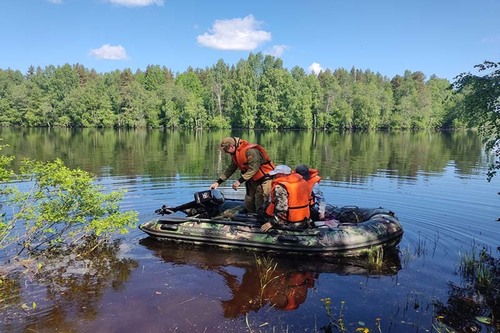
Roman Zdorovennov, Andrey Balagansky and Mikhail Zobkov conducting hydrophysical measurements in the Sandalka River
The estimated values of dissolved organic carbon removal for the studied watercourses are quite high - higher than in the neighboring regions. One of the possible reasons is that the watercourses are of low order and there are no lakes in their catchment area.
The forest lake Chudesnaya Lamba is a small paludified water body where organic forms of carbon dominate in the water. The highest CO2 concentrations were recorded during the ice-covered period, which drop by half after the ice cover break-up.
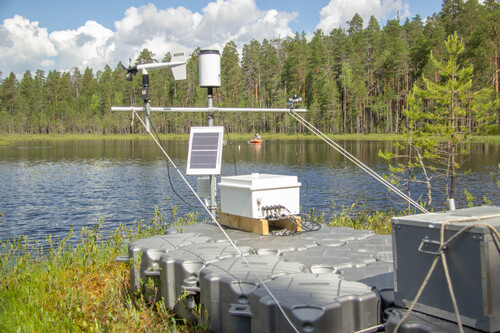
Weather station at Lake Chudesnaya Lamba
— This body of water is not quite ordinary. It is getting overgrown, with large aggregations of moss found on the bottom. We believe that one of the sources of carbon dioxide in the lake is bacteria functioning inside the moss, — shared Yulia Lukina.
It was demonstrated that Lake Chudesnaya Lamba is a sink of organic matter. The thickness of bottom sediments determined by coring is about two meters. Some 70-100 kg of organic carbon is buried beneath each square meter of the lake bed. It is preliminarily estimated that the stock of carbon in the lake sediments is about 690 tons, and the rate of its accumulation is about 0.85 ton per year.
Original gas traps were designed to measure the flux of carbon dioxide from sediments into the water column. It was found that the CO2 flux rate depends on the season: it is the highest in the ice-covered period and the lowest in summer.
To estimate CO2 emission from the lake surface scientists studied the mixing mechanism, which controls the possibility of gas transfer to the atmosphere. The free-convection mechanism of mixing in small forest lakes where the wind impact is minor was established for the first time. Full mixing of the water column of such lakes is observed after ice breakup in spring and in the fall. It is during these periods that greenhouse gases emissions are at their maximum. However, Karelian scientists have found that mixing and emission are also possible in the summer season, occurring at night, when the surface of the lakes cools down. The rate of gas transfer along the water column was estimated for the first time.
Based on the research results, specialists from NWPI KarRC RAS made a preliminary assessment of the lateral flow of various forms of carbon from the catchment area, and estimated the various components of the carbon balance in Lake Chudesnaya Lamba.
– In 2025, we will continue working on the Russian Climate Monitoring System project, and ToR for the next three years are currently being negotiated. We plan to expand the monitoring network to study the stocks and fluxes of climate-active gases in aquatic and terrestrial ecosystems of Northwest Russia, – Olga Bakhmet summed up.




